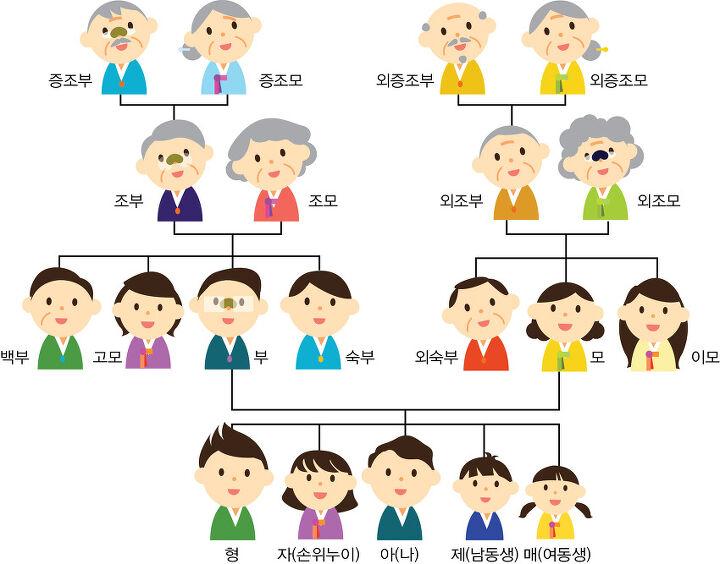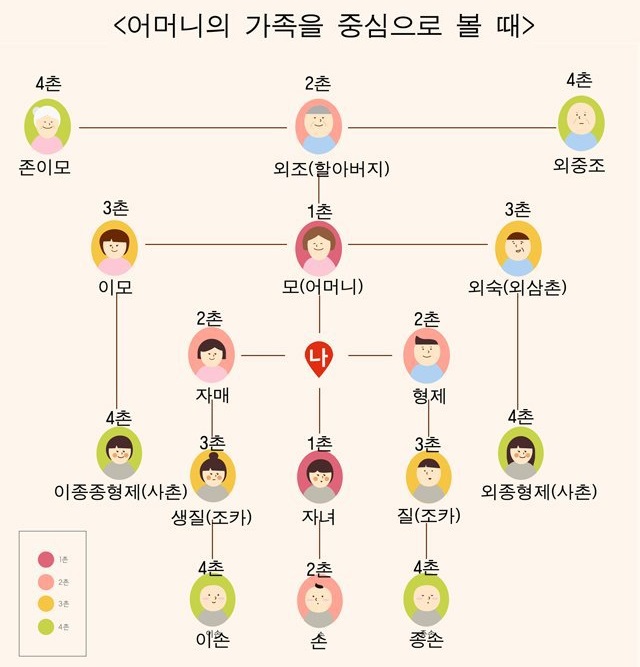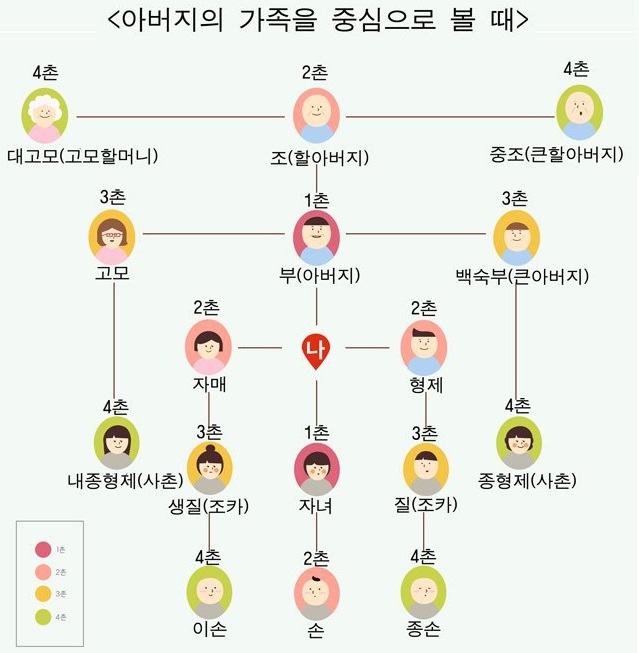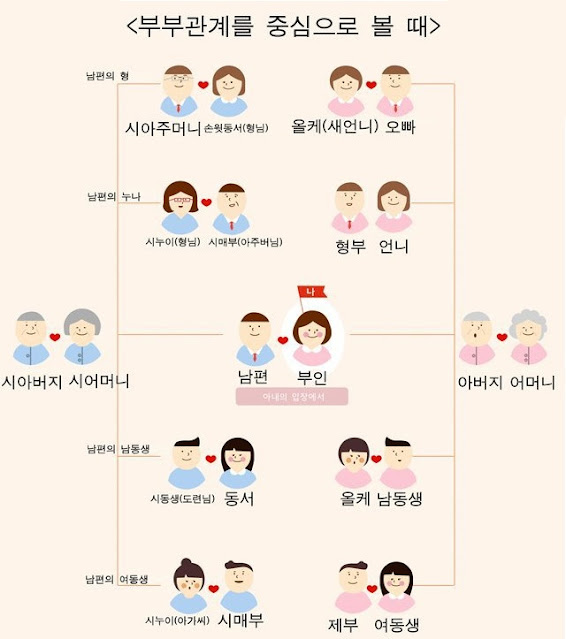
KIIP 5 (기본) – Lesson 2: 가족 Family
1. 한국의 가족은 어떤 특징을 가지고 있을까?
What characteristics do Korean families have?
가족 형태의 변화
한국에서 결혼은 보통 30 세 전후에 많이 하는 편인데, 최근 들어 30 대 중후반정도에 하는 경우가 늘어나 결혼하는 연령이 점점 높아지고 있다. 과거에는 결혼 후에도 부모와 같이 사는 자녀가 많아 조부모, 부모, 자녀 등 여러 세대의 가족이 같이 모여 사는 확대가족 형태가 일반적이었다.
Changes in family structure
In Korea, people usually get married around the age of 30, but recently, the number of people getting married in their mid to late 30s has been increasing, and the average age of marriage is gradually rising. In the past, it was common for children to live with their parents even after marriage, so extended families with multiple generations such as grandparents, parents, and children living together were the norm.
편이다: used to indicate that something tends to be a certain way or falls into a certain category; often translated as “tend to”, “usually”, or “rather” (e.g., 많이 하는 편이다 = tend to do it a lot)
중후반: the middle to latter part (e.g., 30대 중후반 = mid to late 30s)
확대가족: extended family (a family structure in which multiple generations such as grandparents, parents, and children live together)
그러나 산업화와 함께 큰 도시에 학교와 회사 등이 많이 생기면서 공부나 취업을 위해 부모와 떨어져 생활하는 자녀들이 증가하였다. 이와 함께 결혼한 자녀가 부모와 함께 사는 경우가 크게 줄면서, 부모와 미혼 자녀가 함께 사는 핵가족의 모습을 주로 볼 수 있다. 또한 공부나 일 등을 하는 과정에서 결혼을 하지 않거나, 결혼을 하더라도 자녀를 낳지 않고 살겠다는 사람들이 늘어나면서 1인 가구나 부부만 사는 비율이 증가하고 있다.
However, with industrialization and the emergence of many schools and companies in large cities, the number of children living apart from their parents for the purpose of studying or working has increased. Along with this, the number of married children living with their parents has significantly decreased, and nuclear families consisting of parents and unmarried children have become the most common. In addition, as people go through the process of studying or working, more are choosing not to get married, or even if they do, they decide not to have children, leading to an increase in the proportion of single-person households or couples living alone.
산업화: industrialization
취업: employment, getting a job
떨어지다: to be separated, to live apart
증가하다: to increase, to rise
핵가족: nuclear family (a family consisting of parents and their unmarried children)
비율: ratio, proportion
가족 문화의 특징
한국인은 개인의 행복뿐만 아니라 가족 간의 유대관계를 중요하게 생각한다. 그래서 명절, 조상의 제삿날, 가족 (부모)의 생일, 어버이날 등이 되면 멀리 떨어져 있던 가족들도 한자리에 모이는 경우가 많다.
Characteristics of Family Culture
Koreans value not only individual happiness but also the bonds between family members. Therefore, on holidays, ancestral memorial days, parents’ birthdays, or Parents’ Day, it is common for family members who live far apart to gather together in one place.
뿐만 아니라: not only… but also
유대: bond, connection, tie (especially emotional or relational ties between people)
제삿날: ancestral memorial day; the day on which memorial rites (jesa) for deceased ancestors are held
전통적인 한국의 가족은 유교, 효 사상 등의 영향으로 가족 구성원 간의 서열이나 역할을 명확하게 나누었다. 그러나 사회 변동과 함께 가족 형태와 가치관이 달라지면서 가족 구성 원의 역할과 가족 문화에도 변화가 생겼다. 예를 들어, 가족의 중요한 일을 남자 어른 혼자 결정하지 않고 가족 구성원이 함께 의논하여 결정하거나, 집안일이나 육아에 부부가 함께 참여하는 모습 등이 늘어나고 있다. 또한, 명절이나 생일에 가족이 한 집에 모이는 대신 가족 여행을 가는 경우도 많아지고 있다.
Traditional Korean families, influenced by Confucianism and the idea of filial piety, clearly divided roles and hierarchy among family members. However, with social changes, family structures and values have shifted, bringing changes to the roles of family members and family culture as well. For example, instead of the male elder making important decisions alone, family members now tend to discuss and decide together, and it is increasingly common for both spouses to share responsibilities for housework and childcare. In addition, instead of gathering in one house on holidays or birthdays, it has become more common for families to go on family trips.
유교: Confucianism
사상: ideology, thought, philosophy (a particular set of beliefs about society or politics)
영향: influence, effect
구성원: member (of a group or family)
간: between, among
서열: rank, hierarchy
역할: role, duty, responsibility
명확하다: to be clear, precise, explicit
가치관: values, system of values (a standard or attitude for judging the worth or importance of something)
어른: adult, elder
결정하다: to decide, to make a decision
의논하다: to discuss, to consult
육아: childcare, parenting
알아두면 좋아요:
1인 가구 증가로 어떤 변화가 나타나고 있을까?
What changes are occurring due to the increase in single-person households?
요즘 ‘1인분’ 반찬, ‘한 끼’같은 소포장 상품, 소형가전 등 1인 가구를 겨냥한 제품이 계속 등장하고 있다. 결혼 시기가 늦춰지고 이혼율 증가, 고령화 현상 등이 나타나면서 1인 가구의 비중이 30 %에 가까워졌는데 이로 인해 주택, 식품, 가전 제품 등 산업 전반에 큰 번화가 일어나고 있다. 작은 크기의 집을 찾는 사람이 늘고 있고 대형마트나 편의점에서는 혼자서 간단히 먹을 수 있는 간편식 매출이 급증하였다. 작은 크기의 가전제품도 많아졌을 뿐 아니라, 가전제품 사는 것 자체를 번거로워 하는 1인 가구를 위해 가전제품을 빌려주는 서비스도 늘어나고 있다.
These days, products targeting single-person households—such as side dishes packaged for one serving, single-meal packs, and small home appliances—are continuously being released. As people marry later, divorce rates increase, and aging becomes more prevalent, the proportion of single-person households has approached 30%. As a result, major changes are occurring across industries such as housing, food, and electronics. More people are looking for smaller-sized homes, and in large supermarkets and convenience stores, sales of ready-to-eat meals that can be consumed alone have surged. Not only has the variety of small-sized home appliances increased, but services that allow people to rent home appliances—catering to single-person households who find buying such items bothersome—are also on the rise
가전: home appliances
겨냥하다: to target
등장하다: to appear, to emerge, to be launched
비중: proportion, weight
전반: the whole, the entirety
간편식: convenience food, ready-to-eat meal
급증하다: to surge, to increase rapidly
자체: itself, on one’s own
번거롭다: cumbersome, inconvenient
늘어나다: to increase, to grow
2. 한국의 가족과 친척은 서로를 어떻게 부를까?
How do Koreans address their family members and relatives?
가족 관계 호칭
한국에서는 가족 관계에서 서로를 부르는 호칭이 있다. 부부 간에는 주로 ‘여보 ‘,’당신 ‘이라고 부르거나 아이가 있을 경우 아이의 이름을 사용하여’OO 아빠 ‘, ‘OO 엄마’라고 부르기도 한다. 배우자의 부모님은 ‘아버님 ‘,’어머님’이라고 부르는데, 다른 사람 앞에서 배우자의 부모님을 지칭할 때는 아내는 남편의 부모님을 ‘시아버지’, ‘시어머니’라고 하고 남편은 아내의 부모님을 ‘장인어른’, ‘장모님’이라고 부른다. 남편의 부모는 아직 아이를 낳지 않은 며느리를 보통 ‘(새) 아가’라고 부른다. 아이를 낳고 나면 며느리를 ‘어멈아’, 아들을 ‘애비야’라고도 부른다. 아내의 부모는 사위를 부를 때 사위의 성을 앞에 붙여서 ‘O 서방’이라고 부른다. 예를 들어, 사위가 박 씨이면, ‘박서방’이라고 한다. 최근에는 양성평등의 정신을 더욱 잘 실현하기 위해 아내의 가족과 남편의 가족에 대한 호칭 구분을 없애자는 제안 나오고 있다.
Forms of Address in Family Relationships
In Korea, there are specific terms used to address each other within family relationships. Between spouses, they usually call each other “yeobo” or “dangsin,” or, if they have children, they may use the child’s name and say “OO’s dad” or “OO’s mom.” One refers to their spouse’s parents as “abeonim” and “eomeonim,” but when referring to them in front of others, a wife calls her husband’s parents “siabeoji” and “sieomeoni,” while a husband refers to his wife’s parents as “jangin-eoreun” and “jangmonim.” The husband’s parents usually call a daughter-in-law who has not yet had children “(sae) aga.” After she gives birth, they may call the daughter-in-law “eomeoma” and the son “aebiya.” The wife’s parents, when addressing their son-in-law, usually attach his surname in front of “seobang.” For example, if the son-in-law’s surname is Park, they call him “Park-seobang.” Recently, there have been suggestions to eliminate the distinctions in family terms between the wife’s and husband’s sides in order to better reflect the principle of gender equality.
지칭하다: to refer to, to address
며느리: daughter-in-law
양성평등: gender equality
정신: spirit, mindset, mentality
실현하다: to realize, to implement
호칭: title, term of address
없애자: let’s eliminate, let’s get rid of
제안: suggestion, proposal
친척 관계 촌수
한국에서는 가족과 친척 관계를 ‘촌수‘로 표시한다. 남편과 아내는 동일한 위치에 있다고 보기 때문에 촌수를 따지지 않는다. 부모와 자녀는 1 촌, 형제 자매는 2 촌이다. 내가 결혼을 해서 자녀를 낳았다면, 나의 남동생과 내 자녀는 3촌이 된다. 나의 남동생의 자녀와 내 자녀는 4 촌이 된다. 일반적으로 남편이나 아내의 형제자매에게서 태어난 자녀와 내 자녀의 관계를 ‘사촌‘이라고 부른다. 남편의 남자 형제 자녀와는 ‘친사촌‘, 남편의 여자 형제 자녀와는 ‘고종사촌‘, 아내의 남자 형제 자녀와는 ‘외사촌‘아내의 여자 형제 자녀와는 ‘이종 사촌‘이라고 부른다.
Degrees of Kinship Among Relatives
In Korea, family and relative relationships are expressed using “chonsu” (degree of kinship). Since the husband and wife are considered to be in the same position, chonsu is not applied between them. The relationship between parents and children is 1-chon, and between siblings, it is 2-chon. If I get married and have a child, then the relationship between my younger brother and my child becomes 3-chon. The relationship between my younger brother’s child and my own child becomes 4-chon. In general, the children of a spouse’s siblings and my own children are referred to as “sachon” (cousins). A child of the husband’s brother is called “chinsachon,” a child of the husband’s sister is “gojongsachon,” a child of the wife’s brother is “oesachon,” and a child of the wife’s sister is called “ijongsachon.”
촌수: degree of kinship (a number that indicates how close or distant relatives are)
동일하다: to be the same, to be identical
따지다: to calculate, to distinguish, to consider in detail
형제자매: siblings (brothers and sisters)
사촌: cousin
친사촌: paternal cousin (child of the father’s brother)
고종사촌: cousin through the father’s sister (child of the father’s sister)
외사촌: maternal cousin (child of the mother’s brother)
이종사촌: cousin through the mother’s sister (child of the mother’s sister)


알아두면 좋아요: The terms of address used for the husband’s family and the wife’s family are different, as follows:


#KIIP5 #KIIP5NEWBOOK
